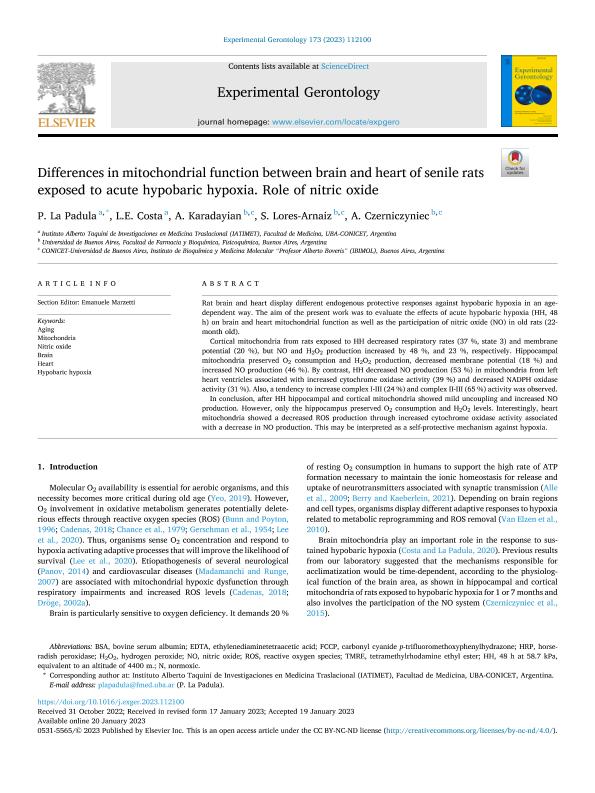Artículo
Differences in mitochondrial function between brain and heart of senile rats exposed to acute hypobaric hypoxia: Role of nitric oxide
La Padula, P.; Costa, Lidia Esther ; Karadayian, Analia Graciela
; Karadayian, Analia Graciela ; Lores Arnaiz, Silvia
; Lores Arnaiz, Silvia ; Czerniczyniec, Analia
; Czerniczyniec, Analia
 ; Karadayian, Analia Graciela
; Karadayian, Analia Graciela ; Lores Arnaiz, Silvia
; Lores Arnaiz, Silvia ; Czerniczyniec, Analia
; Czerniczyniec, Analia
Fecha de publicación:
01/2023
Editorial:
Pergamon-Elsevier Science Ltd
Revista:
Experimental Gerontology
ISSN:
0531-5565
Idioma:
Inglés
Tipo de recurso:
Artículo publicado
Clasificación temática:
Resumen
Rat brain and heart display different endogenous protective responses against hypobaric hypoxia in an age-dependent way. The aim of the present work was to evaluate the effects of acute hypobaric hypoxia (HH, 48 h) on brain and heart mitochondrial function as well as the participation of nitric oxide (NO) in old rats (22-month old). Cortical mitochondria from rats exposed to HH decreased respiratory rates (37 %, state 3) and membrane potential (20 %), but NO and H2O2 production increased by 48 %, and 23 %, respectively. Hippocampal mitochondria preserved O2 consumption and H2O2 production, decreased membrane potential (18 %) and increased NO production (46 %). By contrast, HH decreased NO production (53 %) in mitochondria from left heart ventricles associated with increased cytochrome oxidase activity (39 %) and decreased NADPH oxidase activity (31 %). Also, a tendency to increase complex I-III (24 %) and complex II-III (65 %) activity was observed. In conclusion, after HH hippocampal and cortical mitochondria showed mild uncoupling and increased NO production. However, only the hippocampus preserved O2 consumption and H2O2 levels. Interestingly, heart mitochondria showed a decreased ROS production through increased cytochrome oxidase activity associated with a decrease in NO production. This may be interpreted as a self-protective mechanism against hypoxia.
Palabras clave:
AGING
,
BRAIN
,
HEART
,
HYPOBARIC HYPOXIA
,
MITOCHONDRIA
,
NITRIC OXIDE
Archivos asociados
Licencia
Identificadores
Colecciones
Articulos (IATIMET)
Articulos de INSTITUTO ALBERTO C. TAQUINI DE INVESTIGACIONES EN MEDICINA TRASLACIONAL
Articulos de INSTITUTO ALBERTO C. TAQUINI DE INVESTIGACIONES EN MEDICINA TRASLACIONAL
Articulos(IBIMOL)
Articulos de INSTITUTO DE BIOQUIMICA Y MEDICINA MOLECULAR
Articulos de INSTITUTO DE BIOQUIMICA Y MEDICINA MOLECULAR
Citación
La Padula, P.; Costa, Lidia Esther; Karadayian, Analia Graciela; Lores Arnaiz, Silvia; Czerniczyniec, Analia; Differences in mitochondrial function between brain and heart of senile rats exposed to acute hypobaric hypoxia: Role of nitric oxide; Pergamon-Elsevier Science Ltd; Experimental Gerontology; 173; 1-2023; 1-9
Compartir
Altmétricas



